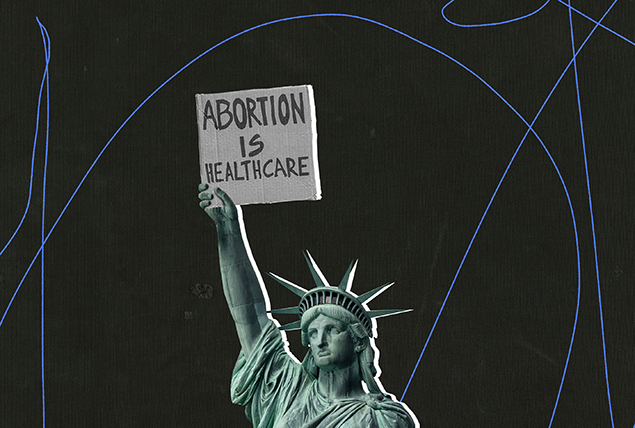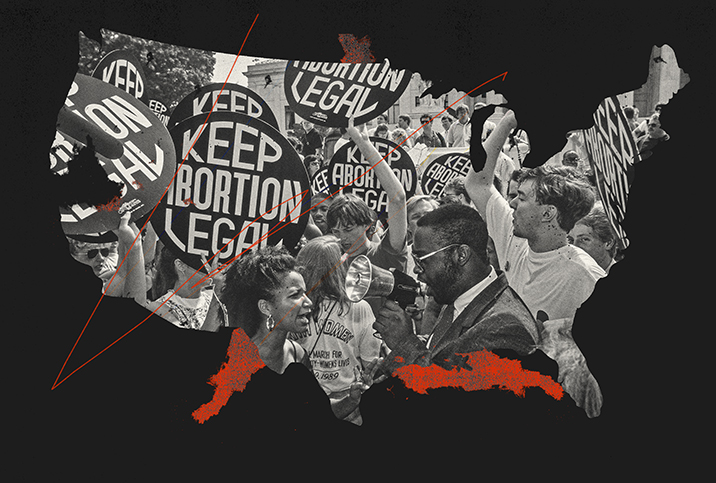What Was Abortion Like in Early America?

Since the U.S. Supreme Court's Dobbs v. Jackson Women's Health decision, which reversed the court's landmark 1973 decision on Roe v. Wade, the discussion around abortion and state efforts to ban or protect access has been a prominent fixture in news cycles and political debates, with supporters on both sides of the issue speaking out.
In today’s America, abortion access is a complex and emotionally fraught subject, at once linked to religious, political, racial and even economic concerns. However, historians say reproductive rights were not an issue in America's formative years.
"Abortion was just a fact of many women's lives in Colonial and early America," said Evan Hart, Ph.D., an assistant professor of history at Missouri Western State University. "Reproductive health was considered the purview of women and women only. During childbirth, women were attended by midwives, female family members and female community members. If a woman's period was late, either due to pregnancy or other health issues, it was not unusual for her to decide if she wanted to bring on menstruation."
Early European colonists retained most of their laws and perspectives on reproductive care from England, where abortion before quickening was legal and accepted. With the exception of enslaved people, whose children were considered property, reproductive care was generally unrestricted.
"Women weren't considered pregnant with a living being until quickening, the point at which a woman can feel the child move or kick," Hart continued. "So there really wasn't any moral concern for women terminating pregnancies before quickening. Especially early in pregnancy, women couldn't be certain they even were pregnant. Many genuinely thought of it as bringing on menstruation."
Benjamin Franklin included a detailed recipe for an abortifacient in his widely distributed math textbook, "The Instructor," in the 1740s. The text doesn't appear to have received any criticism for the inclusion.
Early America's attitude toward abortion, much like the enshrinement of rights in the 1973 Roe case, was relatively short-lived. Some experts see history repeating itself.
Mixing abortifacient recipes
Julia Arnold VanRooyen, M.D., a gynecological surgeon based in Wayland, Massachusetts, said references to abortifacients exist in literature and art dating back centuries, with various methods of abortion induction known throughout early North America.
"Women in native tribes used herbs such as black root and red cedar, also known as juniper savin, and external physical methods, including beating the abdomen with rocks," she said. "European colonizers brought similar information with them to their American settlements."
Hart and Rebecca Kluchin, Ph.D., an associate professor of history at California State University, Sacramento, said it's unknown precisely how prevalent abortions were in Colonial and early America, but it was likely widely practiced. It was common to have abortifacient recipes in home medical texts or other recipe books, and abortifacient products were widely advertised.
"This suggests that it was assumed women would have a need for these recipes," Hart said. "Even enslaved women learned of these and other remedies."
In fact, more than half of reproductive care providers were Black women, some of whom were enslaved, according to an essay by Michele Goodwin, a law professor at the University of California, Irvine.
Remedies included herbal mixtures containing substances such as pennyroyal, tansy, quinine, rue, black hellebore, ergot of rye, savin, cotton root and turpentine.
"These substances rarely had specific dosing instructions or mixture amounts, Ben Franklin's recipe being the exception, and while these herbs could succeed in inducing abortion, they were also frequently toxic to the pregnant woman, resulting in kidney and liver damage or even death," Arnold said.
In the 19th century, with the dawn of the print era, remedies to "restore menses" were commonly advertised in newspapers and magazines, Kluchin said, describing the ads as a type of "code." While most readers may have perceived them as simple pills or potions to regulate the menstrual cycle, women understood them to be abortifacients.
Arnold said that although some herbal and plant-based methods are still used in "natural" treatments today, there's no solid evidence they are effective.
"It's important to note that these remedies could be dangerous or even fatal," Hart said. "Pregnant people should not seek these recipes out."
Surgical intervention, necessary for post-quickening abortions, was even more perilous. Germ theory and anesthesia hadn't yet been discovered, Arnold said, and even if one of these "primitive" surgical procedures was effective, patients frequently died of infection afterward.
"Occasionally in early America, women would use pessaries to irritate the cervix, causing it to dilate," Hart said. "They could also use inserted herbs to cause dilation. Surgical methods were possible, but they were dangerous. Surgical methods became more popular in the 19th century."
Social perceptions on sex and reproductive care
Despite their proclivity for scarlet letters and hanging "witches," even the Puritans weren't exceptionally austere with regard to abortion. The group believed reproduction wasn't essential to maintain a godly life and that life did not begin before quickening, so their strict religious beliefs bore little impact on the subject. There's no reason to think the Puritans dealt with abortion differently than other communities of the time, according to Kluchin.
Until 1850, even the Catholic Church, which taught members that the fetus became ensouled upon quickening, didn't recognize abortion before quickening and "certainly didn't call it a sin," Kluchin added.
Abortion as a moral crusade did not take off until after the Roe decision, Hart said.
"This isn't to say there was no moral opposition to abortion before this, but it didn't really become a moral crusade the way many Americans think of it now until after 1973," Hart added.
The first laws to regulate abortion, passed in the 1820s and 1830s, were poison control measures designed to protect pregnant women amid the high mortality rate. Subsequent abortion laws, which every state eventually had, often had more to do with power delegation than ethics.
"Early laws were attempts to protect women, but most of the laws were passed to help solidify the power of professional physicians," Hart said. "Groups like the American Medical Association [AMA] were concerned about the practice of midwifery and lay doctors. Professional doctors believed medicine had a poor reputation because of these groups. Not all doctors necessarily opposed abortion in all cases, but they certainly believed only physicians should be able to perform them. This, in part, is why pretty much all states had clauses allowing doctors to perform abortions in cases of medical necessity."
How the AMA changed reproductive care
For better or worse, the advent of the AMA was a catalyst for change, with physicians fighting to be seen as professionals, Hart said. At the time of the association's formation in 1847, various people were involved in healthcare. Women cared for their families, midwives tended to family and reproductive health matters, and doctors could set up shop with or without training or official credentials. The latter camp encompassed a broad spectrum of providers, including doctors trained at legitimate medical schools, as well as those with what Kluchin referred to as a "pay-to-play" degree.
"The founding of the AMA also coincided with the era of criminalization of abortion in the United States," Arnold said. "As part of the efforts to push midwives out of medicine, making abortion illegal became one of the AMA's top priorities. They called abortion 'immoral' and a 'dangerous medical procedure.'"
Hart said college-educated physicians, striving to become the only legal medical providers, saw abortion as an area where they could exert power and influence. While AMA members were not solely responsible for the passage of abortion bans, they were integral, Hart said.
In tandem with the AMA's establishment, in 1857, Harvard-trained physician and religious zealot Horatio Robinson Storer led what has been called "the physicians' crusade against abortion," professing abortion's moral turpitude to physicians and politicians nationwide.
Touting beliefs akin to those held by today's anti-abortion proponents, Storer proclaimed women who sought or received pregnancy terminations had fallen off the moral path and required the guidance of exclusively white and male organized medicine to set them straight. Moreover, he said, men who did not prevent their wives from terminating a pregnancy were as devoid of morality as people who sought prostitutes.
Together, Storer's campaign and the AMA's efforts were integral in changing public perception and policy of abortion.
"Throughout the latter half of the 1800s, the AMA supported state abortion bans except in very specific circumstances, such as when necessary to save the mother's life," Arnold said. "The AMA strongly believed physicians, again, all male, should be the only ones to determine who should be able to have an abortion. To protect their clinical autonomy, they did not want the state to ban all abortions, but they certainly did not want women to be able to seek them on demand."
By 1910, all states had banned abortion, with several also prohibiting contraception. Although Roe cemented the federal right to choose many decades later, it also reignited anti-abortion fervor. In the decades since, Arnold said, a vocal minority has once again "worked doggedly" to encroach upon reproductive rights, and ultimately succeeded, at least for the time being.
Sallie Han, Ph.D., a professor of cultural anthropology at State University of New York (SUNY) Oneonta and the author of "Pregnancy in Practice: Expectation and Experience in the Contemporary U.S.," said: "The majority includes people who understand abortion as integral to reproductive justice as well as people who feel much more ambivalent about it, pragmatically recognizing the need for abortion while also lamenting it."


















